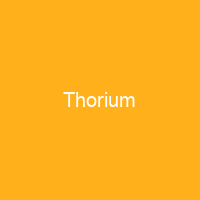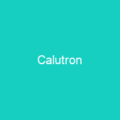Thorium is a weakly radioactive metallic chemical element with the symbol Th and atomic number 90. The most stable isotope, 232Th, has a half-life of 14. 05 billion years, or about the age of the universe. Thorium was discovered in 1828 by the Norwegian amateur mineralogist Morten Thrane Esmark and identified by the Swedish chemist Jöns Jacob Berzelius.
About Thorium in brief

There is a new downward trend in melting points from thorium to plutonium, where the number of f electrons increases from about 0. 4 to about 6: trend is due to increasing hybridisation of the 5f and 6d orbitals and the formation of complex crystal structures. Among actinides up to californium, the highest boiling points and second-lowest density is thorium. Thoriam is nearly half as dense as uranium and plutonium and is harder than both. It becomes superconductive below 1. 4 K. It can be cold-rolled, swaged, and drawn. Pure thorium is very ductile and, as normal for metals, can be rolled into sheets and pulled into wire. At room temperature, Thorium metal has a face-centred cubic crystal structure; it has two other forms, one at high temperature and one atHigh pressure. Thorium has a bulk modulus of 54 GPa, about the same as tin’s. Aluminium’s is 75. 2GPa; copper’s 137. 8 GPa; and mild steel’s is 160–169 GPa. Thorium is about as hard as soft steel, so when heated it can be Rolled into sheets and pull into wire, and can be pulled into sheets, and it becomes superconductor below 1 4°C. It is also used to strengthen magnesium, coating tungsten wire in electrical equipment, controlling the grain size of tungststen in electric lamps, high-temperature crucibles, in glasses and in glasses.
You want to know more about Thorium?
This page is based on the article Thorium published in Wikipedia (as of Nov. 10, 2020) and was automatically summarized using artificial intelligence.







